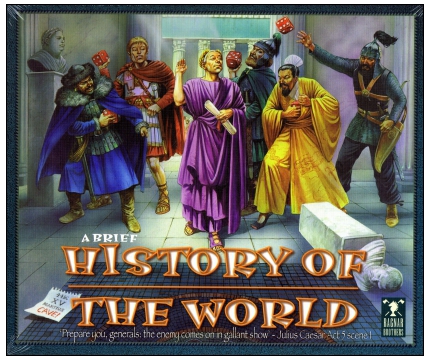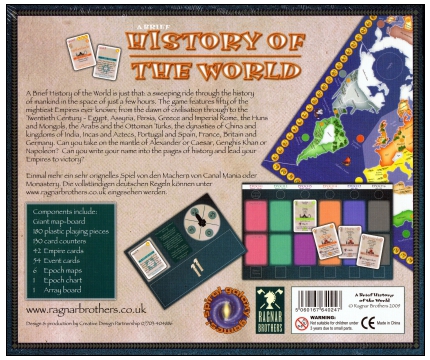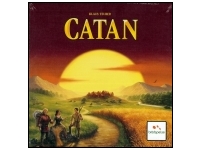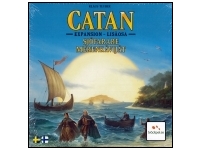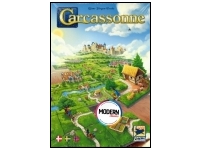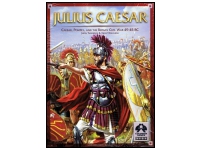-
-
-
-
-
-
Din kundvagn
Din kundvagn är tom. -
-
-
-
-
-
-
A Brief History Of The World
-
6.86 6.86 / 10, (958 röster) - Sätt betyg
-
-
Antal spelare: 3 - 6
Speltid: 180 (min)
Ålder: 14+
-
Regelspråk:

Försälj. rank: 4872/16152
-
-
599 kr
Ej tillgänglig
Tyvärr går det inte att beställa A Brief History Of The World längre.
Det är inte heller troligt att vi kommer få hem produkten igen.
Önskelista: För att kunna använda önskelistan måste du ha ett användarkonto och vara inloggad.
-
-
-
Produktbeskrivning
History of the World has been produced by four different board-game companies: Ragnar Brothers, Gibsons, Avalon Hill and Hasbro. The rights for the game have now returned to Ragnar Brothers and after some speculation we decided it ought to be a Ragnar Brothers product once more. The title is now A Brief History of the World in light of significant developments.
The underlying factors for change were:
Producing a quality, large-scale game aimed at both the hobby and the family market.
Reducing playing time and downtime
As a result, this produced:
New mechanisms
Greater historical ‘accuracy’
The first consideration was how to follow on from Hasbro’s version. Use of plastic pieces in that game had brought it into a more general market, so to revert to cardboard armies would have been a retrograde step. In terms of game mechanics, the only reason for having different armies was to prevent a player’s new empire from absorbing his previous empires as soon as they became adjacent. This in turn could have led to empires suddenly leap-frogging into distant lands, totally out of historic context.
The simple solution in A Brief History of the World is to have armies standing up for a player’s ‘active’ empire and then lying down (‘resigned’) thereafter. An empire can only expand through active armies. Consequently each player needs just one type of army; an imperial bust (see box-top illustration) that can stand or be toppled over. Another major benefit resulting from this is that a player’s armies no longer need to be sorted.
At a very early stage the map terrain was given a shake up. This was one of those elements that in all four versions had never quite bedded down comfortably - far too many rules within rules. New players often misread which side of a border the mountains or forests were on, whilst straits were made complicated by fleets.
Subsequent work concentrated on revising the Empire cards and this led to a reduction in Epochs from seven to six. The bulk of the discarded empires came from the middle part of the game, an area that had often felt flat in previous versions of the game.
A Brief History of the World sees a powerful rise of civilisations in Epochs 1, 2 & 3, followed by the dissolution of the Dark Ages during Epoch 4, the introduction of the New World in Epoch 5 and ending with the colonial era of Epoch 6.
In order to effect such change, Epoch 1 saw the removal of the Babylonians, thus allowing the Assyrians to dominate the Tigris / Euphrates region at the start of Epoch 2. In Epoch 6, Japan was re-instated as an empire, with Netherlands being down-graded to a Minor Empire event. A similar fate befell the Khmers and Chola. Other casualties in the middle part of the game included the Holy Roman Empire and Timurid Emirates. As a consequence the number of Minor Empires and Kingdoms increased.
Tests at an early stage indicated only a limited reduction in game-time, and attention turned to the quantity of dice rolling. With some reluctance the number of lands was reduced, which in turn meant each empire’s army quota diminished. A knock-on effect of this, however, was that player’s good or bad fortune intensified: in the worst case an empire would emerge, attack and …. gain no more land! Not quite what we wanted.
And thus, the whole combat system received an overhaul.
This is the most striking change to game mechanics. In short, an over-run mechanic combines with an invasion bonus thereby smoothing out the swings of fortune. In the course of this it also simplifies terrain (removing altogether any effect for straits) and makes sea-borne invasion a more realistic option. In addition the role of forts is enhanced. More importantly the over-run means less dice rolling and perhaps better represents the expansion of empires; a great victory can mean several lands falling without further resistance.
Such sweeping changes threw up a number of anomalies; for example, multiple empires may now emerge from the same start-land. Rule ‘exceptions’ proliferated to deal with the anomalies, so the decision was made to use these exceptions as empire Features. Thereafter the search was on for more. Some simplification was possible (for example, removing the Great Wall from the map) and fragments of history introduced (for example, the fortification of Byzantium). The ‘Fear’ Feature is a particular favourite – it gives greater speed of conquest and menacing presence to three ruthless empires.
The Features provide an extra layer of detail. Perhaps more importantly, empires can now spread to their historic size. For example, in previous versions the Romans might have managed to conquer the lands surrounding the Mediterranean, but struggled to advance further. Now not only can Rome carry civilzation to Northern Europe and to the Middle East, but also, using the Empire feature, create a fortified frontier. Other empires can perform in equally satisfying manner.
A new card distribution system gives greater to hope to players at the back of the field, whilst giving an opportunity for the person in the lead to benefit from drawing the first Event card.
One play-tester liked the idea of a Gold track made of coins, but felt it was only logical to be able to pay for something. Paying for Events (thereby providing some balance to fortune) had been a latent idea for some years. The system also gives some recompense to anyone drawing an Event which they cannot then make use of.
The Bonus tokens system was introduced in the Hasbro version to encourage players to strive for the lead. We have now reduced the values of the tokens, but increased their number to three per epoch. They still won’t affect the outcome of every game, but we hope the tension will now be prolonged until the final tally of gold.
The introduction of Barbarian reduction makes empires without capitals more lucrative, putting the Empire cards into better balance.
When testing it was evident that players never put more than a minimal number of fleets on the map, hence the combining of ocean and sea placement.
We hope the Epoch chart, the Array, Epoch maps and the layout of Area values on the map itself all help to make the game flow more easily.
And that’s just about it.
We hope players who have never played History of the World will enjoy this game as much as others did the original. We particularly hope that those who know the original will feel that A Brief History of the World has moved the game forward.
-
Speltyp: Strategispel
Kategori: Civilisation, Områdeskontroll
Tillverkare: Övriga
Länkar: Tillverkarens hemsida, BoardGameGeek
Taggar: Lägg till/editera tags
Recension(er)
Det finns tyvärr ingen recension för produkten.
-
-
Plastfickor till A Brief History Of The World
-
Det är totalt 96 st kort som passar i någon av dessa plastfickor
-
-
Personer som har köpt A Brief History Of The World har också köpt
-
A Brief History Of The World
599 kr
Ej tillgänglig
-
-
Kundtjänst
Om du har några frågor eller funderingar är det bara att höra av dig till oss.
E-post: info@worldofboardgames.com
Telefon: 090 - 205 92 11
Adress: Björnvägen 11, 906 40 UMEÅ -
Leveranstid och fraktpriser
Ordrar med varor vi har i lager, och som kommer in innan 12:00 på vardagar, skickas normalt samma dag och har sedan en leveranstid på 1-3 dagar.
Fraktkostnaden är 49 kr med Schenker - Ombud, 75 kr med Postnord - Ombud och 175 kr för hemleverans med Postnord. Företagspaket kostar 99 kr. Du ser din fraktkostnad när du går till kassan. Vid beställningar för minst 2000 kr ger vi fri frakt, gäller dock endast Schenker - Ombud och för privatpersoner.
-
-
-






